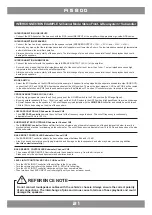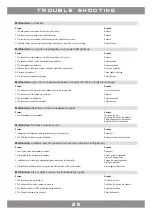
T R O U B L E S H O O T I N G
2 6
PROTECTION CIRCUIT
This amplifier owns a 3-way protection circuit. If overloading, overheating and shorted loudspeakers, or too low
impedance or insufficient power supply is insisted, the amplifier shuts down to prevent serious damage. If one of this
disfunctions is detected, the red PROTECT LED lights up.
Check in this case all connections to detect short-circuits, faulty connections or overheating. Attend the regarding notes
on the previous page.
If the reason for the disfunction is eliminated, the amplifier is ready for operation again.
If the red PROTECT LED does not stop to light up, a damage on the amplifier is insisted. In this case return the amplifier
to your car audio retailer with a detailled malfunction description and a copy of the proof of purchase.
WARNING:
Never open the amplifier and try to repair it by yourself. This causes a loss of warranty. The repairing
service should be made only by skilled technicians.
REFERENCE NOTE
ELECTRICAL INTERFERENCES
The reason for interferences are mostly the passed cables and wires. Especially the power and audio cables (RCA)
of your sound system are vulnerable. Often these interferences are caused by electric generators or other electrical
units (fuel pump, AC etc.) of the car. The most of these problems can be prevented by a correct and careful wiring.
Here are some courtesy notes:
1. Use only double or triple shielded audio RCA cables for the connection between the amplifier and headunit. A useful
alternative are represented by anti-noise-devices or additional ancillary equipment like Balanced Line Transimtters,
which you can purchase at your car audio retailer. If possible do not use anti-noise-filters, which are splicing the
ground of the RCA audio cables.
2. Do not lead the audio cables between the headunit and the amplifier together with the power supply wires on the
same side of the vehicle. The best is a areal separated installation in the left and right cable channel of the vehicle.
Therewith a overlap of interferences on the audio signal will be avoided. This stands also for the equipped bass-
remote wire, which should be installed not together with the power supply wires, but rather with the audio signal
cables.
3. Avoid ground loops by connecting all ground connections in a starlike arrangement. The suitable ground center
point is ascertainable by measuring of the voltage directly on the vehicle’s battery by a multi-meter. You should
measure the voltage with turned-on inginition (acc.) and with other turned-on power consumers (e.g. headlights, rear
window defroster, etc.).Compare the measured value with the voltage of the ground point you have chosen for the
installation and the positive pole (+12V) of the amplifier. If the voltage has just a little difference, you have found a
suitable ground point. Otherwise you need to choose another ground point.
4. Use if possible only cables with added or soldered cable sockets or the like. Gold plated or high value nickel plated
cable sockets are corrosionfree and own a very low contact resistance.
REFERENCE NOTE


































